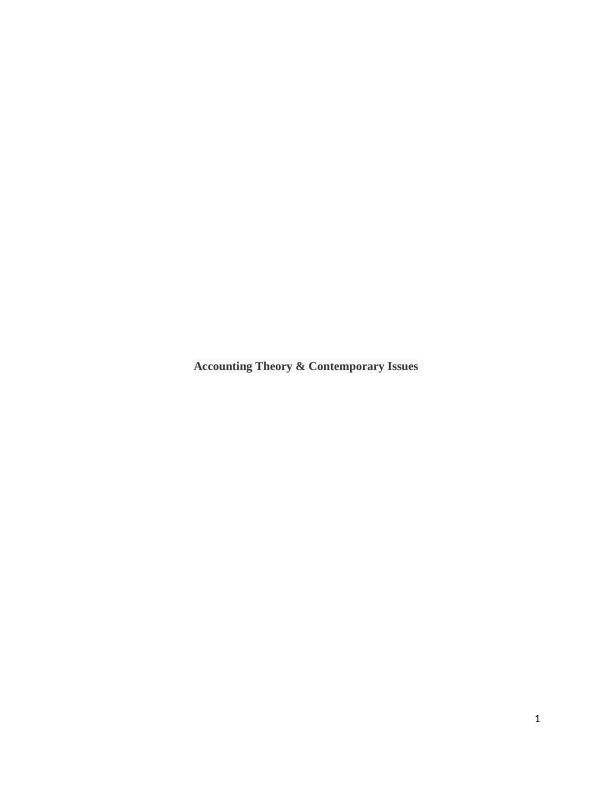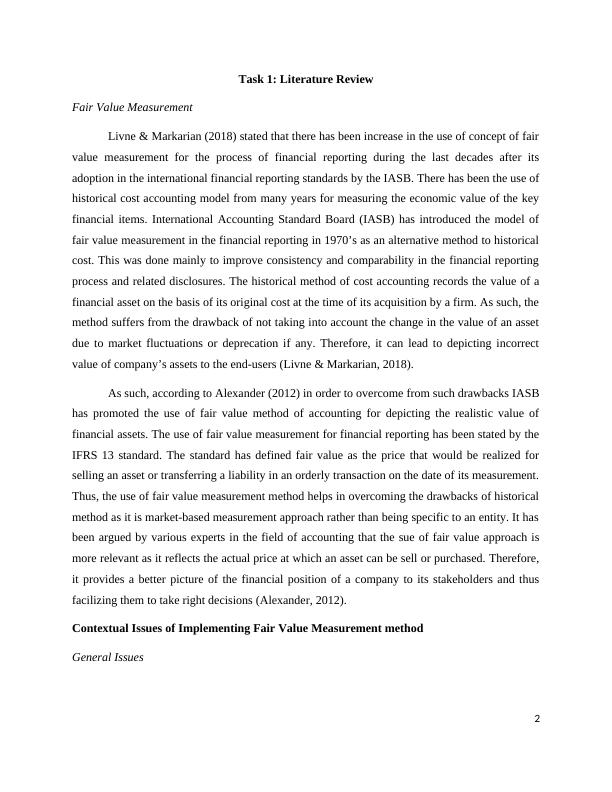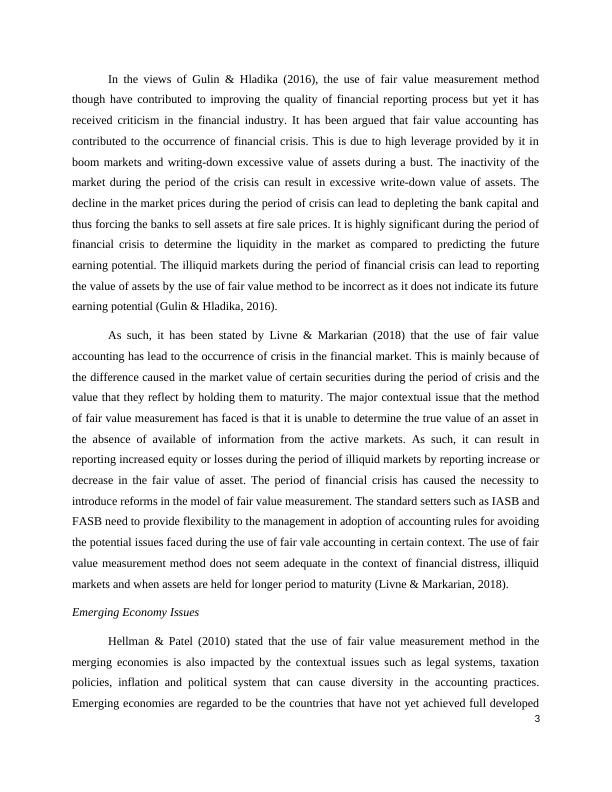Fair Value Measurement: Literature Review and Contextual Issues
Added on 2023-06-08
6 Pages1639 Words273 Views
Accounting Theory & Contemporary Issues
1
1

Task 1: Literature Review
Fair Value Measurement
Livne & Markarian (2018) stated that there has been increase in the use of concept of fair
value measurement for the process of financial reporting during the last decades after its
adoption in the international financial reporting standards by the IASB. There has been the use of
historical cost accounting model from many years for measuring the economic value of the key
financial items. International Accounting Standard Board (IASB) has introduced the model of
fair value measurement in the financial reporting in 1970’s as an alternative method to historical
cost. This was done mainly to improve consistency and comparability in the financial reporting
process and related disclosures. The historical method of cost accounting records the value of a
financial asset on the basis of its original cost at the time of its acquisition by a firm. As such, the
method suffers from the drawback of not taking into account the change in the value of an asset
due to market fluctuations or deprecation if any. Therefore, it can lead to depicting incorrect
value of company’s assets to the end-users (Livne & Markarian, 2018).
As such, according to Alexander (2012) in order to overcome from such drawbacks IASB
has promoted the use of fair value method of accounting for depicting the realistic value of
financial assets. The use of fair value measurement for financial reporting has been stated by the
IFRS 13 standard. The standard has defined fair value as the price that would be realized for
selling an asset or transferring a liability in an orderly transaction on the date of its measurement.
Thus, the use of fair value measurement method helps in overcoming the drawbacks of historical
method as it is market-based measurement approach rather than being specific to an entity. It has
been argued by various experts in the field of accounting that the sue of fair value approach is
more relevant as it reflects the actual price at which an asset can be sell or purchased. Therefore,
it provides a better picture of the financial position of a company to its stakeholders and thus
facilizing them to take right decisions (Alexander, 2012).
Contextual Issues of Implementing Fair Value Measurement method
General Issues
2
Fair Value Measurement
Livne & Markarian (2018) stated that there has been increase in the use of concept of fair
value measurement for the process of financial reporting during the last decades after its
adoption in the international financial reporting standards by the IASB. There has been the use of
historical cost accounting model from many years for measuring the economic value of the key
financial items. International Accounting Standard Board (IASB) has introduced the model of
fair value measurement in the financial reporting in 1970’s as an alternative method to historical
cost. This was done mainly to improve consistency and comparability in the financial reporting
process and related disclosures. The historical method of cost accounting records the value of a
financial asset on the basis of its original cost at the time of its acquisition by a firm. As such, the
method suffers from the drawback of not taking into account the change in the value of an asset
due to market fluctuations or deprecation if any. Therefore, it can lead to depicting incorrect
value of company’s assets to the end-users (Livne & Markarian, 2018).
As such, according to Alexander (2012) in order to overcome from such drawbacks IASB
has promoted the use of fair value method of accounting for depicting the realistic value of
financial assets. The use of fair value measurement for financial reporting has been stated by the
IFRS 13 standard. The standard has defined fair value as the price that would be realized for
selling an asset or transferring a liability in an orderly transaction on the date of its measurement.
Thus, the use of fair value measurement method helps in overcoming the drawbacks of historical
method as it is market-based measurement approach rather than being specific to an entity. It has
been argued by various experts in the field of accounting that the sue of fair value approach is
more relevant as it reflects the actual price at which an asset can be sell or purchased. Therefore,
it provides a better picture of the financial position of a company to its stakeholders and thus
facilizing them to take right decisions (Alexander, 2012).
Contextual Issues of Implementing Fair Value Measurement method
General Issues
2

In the views of Gulin & Hladika (2016), the use of fair value measurement method
though have contributed to improving the quality of financial reporting process but yet it has
received criticism in the financial industry. It has been argued that fair value accounting has
contributed to the occurrence of financial crisis. This is due to high leverage provided by it in
boom markets and writing-down excessive value of assets during a bust. The inactivity of the
market during the period of the crisis can result in excessive write-down value of assets. The
decline in the market prices during the period of crisis can lead to depleting the bank capital and
thus forcing the banks to sell assets at fire sale prices. It is highly significant during the period of
financial crisis to determine the liquidity in the market as compared to predicting the future
earning potential. The illiquid markets during the period of financial crisis can lead to reporting
the value of assets by the use of fair value method to be incorrect as it does not indicate its future
earning potential (Gulin & Hladika, 2016).
As such, it has been stated by Livne & Markarian (2018) that the use of fair value
accounting has lead to the occurrence of crisis in the financial market. This is mainly because of
the difference caused in the market value of certain securities during the period of crisis and the
value that they reflect by holding them to maturity. The major contextual issue that the method
of fair value measurement has faced is that it is unable to determine the true value of an asset in
the absence of available of information from the active markets. As such, it can result in
reporting increased equity or losses during the period of illiquid markets by reporting increase or
decrease in the fair value of asset. The period of financial crisis has caused the necessity to
introduce reforms in the model of fair value measurement. The standard setters such as IASB and
FASB need to provide flexibility to the management in adoption of accounting rules for avoiding
the potential issues faced during the use of fair vale accounting in certain context. The use of fair
value measurement method does not seem adequate in the context of financial distress, illiquid
markets and when assets are held for longer period to maturity (Livne & Markarian, 2018).
Emerging Economy Issues
Hellman & Patel (2010) stated that the use of fair value measurement method in the
merging economies is also impacted by the contextual issues such as legal systems, taxation
policies, inflation and political system that can cause diversity in the accounting practices.
Emerging economies are regarded to be the countries that have not yet achieved full developed
3
though have contributed to improving the quality of financial reporting process but yet it has
received criticism in the financial industry. It has been argued that fair value accounting has
contributed to the occurrence of financial crisis. This is due to high leverage provided by it in
boom markets and writing-down excessive value of assets during a bust. The inactivity of the
market during the period of the crisis can result in excessive write-down value of assets. The
decline in the market prices during the period of crisis can lead to depleting the bank capital and
thus forcing the banks to sell assets at fire sale prices. It is highly significant during the period of
financial crisis to determine the liquidity in the market as compared to predicting the future
earning potential. The illiquid markets during the period of financial crisis can lead to reporting
the value of assets by the use of fair value method to be incorrect as it does not indicate its future
earning potential (Gulin & Hladika, 2016).
As such, it has been stated by Livne & Markarian (2018) that the use of fair value
accounting has lead to the occurrence of crisis in the financial market. This is mainly because of
the difference caused in the market value of certain securities during the period of crisis and the
value that they reflect by holding them to maturity. The major contextual issue that the method
of fair value measurement has faced is that it is unable to determine the true value of an asset in
the absence of available of information from the active markets. As such, it can result in
reporting increased equity or losses during the period of illiquid markets by reporting increase or
decrease in the fair value of asset. The period of financial crisis has caused the necessity to
introduce reforms in the model of fair value measurement. The standard setters such as IASB and
FASB need to provide flexibility to the management in adoption of accounting rules for avoiding
the potential issues faced during the use of fair vale accounting in certain context. The use of fair
value measurement method does not seem adequate in the context of financial distress, illiquid
markets and when assets are held for longer period to maturity (Livne & Markarian, 2018).
Emerging Economy Issues
Hellman & Patel (2010) stated that the use of fair value measurement method in the
merging economies is also impacted by the contextual issues such as legal systems, taxation
policies, inflation and political system that can cause diversity in the accounting practices.
Emerging economies are regarded to be the countries that have not yet achieved full developed
3

End of preview
Want to access all the pages? Upload your documents or become a member.
Related Documents
Study on Accounting and Financial Reportinglg...
|6
|2073
|29
Financial Accounting Theory & Practice .lg...
|10
|2262
|206
Accounting Policy based on IASB Conceptual Frameworklg...
|11
|2928
|355
Financial Crisis | US Financial System Meltdown Reportlg...
|6
|1531
|50
Comparison of Fair Value and Historical Cost Accounting: A Case Study of Wesfarmerslg...
|10
|2719
|455
Assignment - Financial Accountinglg...
|6
|1230
|64
